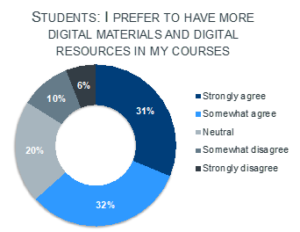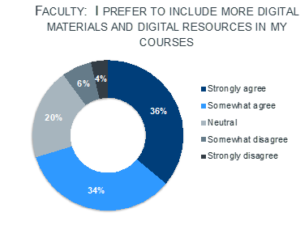Dr. Jeff Seaman, Director of Bay View Analytics, has been conducting research in higher education for nearly two decades.
The future of education materials has always been digital. The only question has been, “how soon?” To answer that question, we need to understand the factors driving this change.
The Digital Learning Pulse Survey (DLPS) project can help provide a better understanding of these factors. A series of six surveys conducted from Spring 2020 to Spring 2022, the DLPS examined changes in teaching and learning, and can help provide an overview of the overall educational landscape for publishers. Here are a few key insights from the project.
Price makes a difference.
Digital instruction materials are generally less expensive for students than print. A decade ago, faculty rarely listed the price of their course materials as a critical component in their selection process. In fact, many faculty did not even know how much the student had to pay for their required textbook. That has changed. Faculty and administrators are now aware of the need to provide affordable materials for their students, and, most often, are including or switching to more cost-effective digital versions.
The supply is changing.
Commercial publishers have been aggressively moving to all-digital distribution systems. This changing market dynamic means many more digital options are available than there were only a few years ago. In addition, publishers are doing more than just converting text from print to digital; some materials include digital-only interactive features, such as student notes and annotations, that are not possible in a printed book. The result has been a growing range of digital materials for faculty to consider.
Experience matters.
The pandemic required a massive, mandatory shift to remote learning. Academic leaders expressed considerable concern that this forced online instruction would sour students and faculty on the whole digital experience. This has not happened. Instead, during the pandemic the large-scale adoption of digital instruction materials provided faculty and students with a real-time laboratory. Students and faculty alike understood the uniqueness of the situation, and, if anything, are more enthusiastic about digital options than they were before.
In the wake of COVID-19, both students and faculty came away with a greater appreciation for digital instruction, video technologies, and a belief that future teaching should evolve from its pre-pandemic norms. They found their experience compelling, so much so that they now overwhelmingly prefer increased use of digital course materials.
Attitudes are changing.
Growing acceptance of digital instruction materials is not new. Prior Bay View Analytics research demonstrated increasing faculty adoption in recent years, with faculty opinion becoming more optimistic about digital materials than traditional print products. However, what is new is the acceleration of this trend. It is no longer slow and steady but now rapid.
The Spring 2022 DLPS survey showed that 46% of faculty were now more optimistic about using digital course materials than before the pandemic, compared to only 8% who were more pessimistic. Results for academic administrators mirrored those of the faculty, with 51% more optimistic and only 7% more pessimistic.
More digital now, even more to come.
A natural result of the growing appreciation of digital instruction materials is the increasing proportion of faculty who report that they intend to use more digital materials in the future. The Fall 2021 DLPS asked faculty about their future use of digital materials. More than two-thirds (70%) of faculty agreed or strongly agreed that their preference was for increased use, with only 10% disagreeing.
It’s not just faculty.
The results for students were similar, with 63% of the Fall 2021 DLPS respondents reporting that they preferred to have more digital materials included in their courses. This result is not surprising; 48% of students are more optimistic about digital than before the pandemic.

It is clear. Both students and faculty agree – digital materials are at the core of the future of education. And that digital future is soon to be the present.
Join us for a deeper discussion on the Digital Learning Pulse Survey (DLPS) results on July 27. Plus, learn how institutional leaders are responding to student demand with agile teaching.
Stay connected with us on social media platform for instant update click here to join our Twitter, & Facebook
We are now on Telegram. Click here to join our channel (@TechiUpdate) and stay updated with the latest Technology headlines.
For all the latest Education News Click Here
For the latest news and updates, follow us on Google News.

